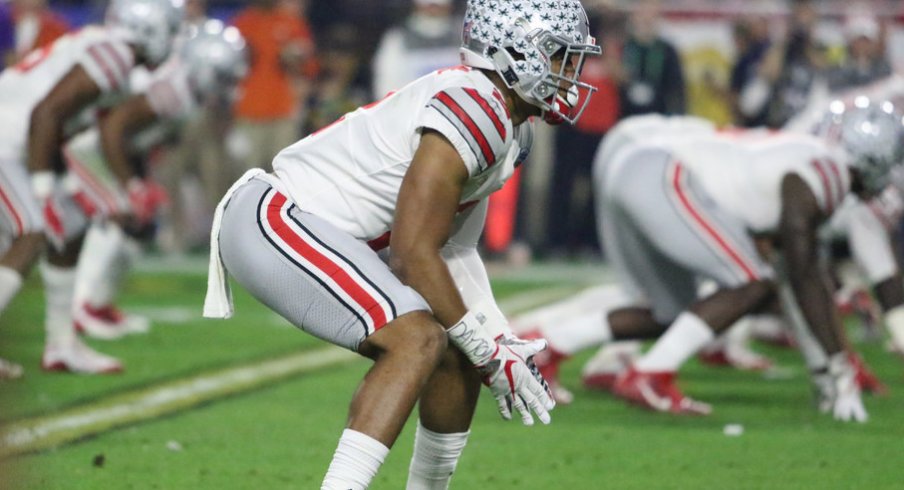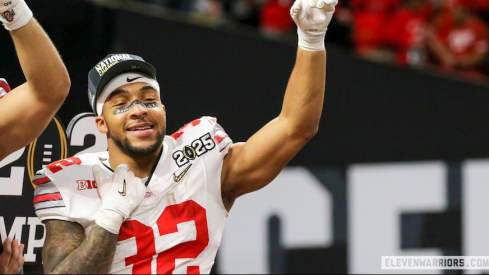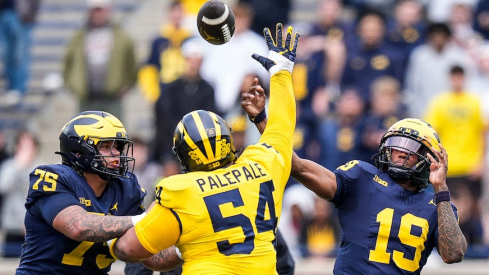Despite the game's hard-nosed reputation, analytics have long been a big part of football.
Thanks to the constant re-setting of the ball, the down and distance to gain, and a playing surface lined in a grid pattern; coaches, scouts, analysts, and fans have long depended on numbers to digest and understand a game that throws 22 people into a blender for six seconds or more at a time. Despite relatively few games on the schedule when compared to sports like baseball or basketball, CFBstats.com still lists 52 statistical categories for fans to search on their website, breaking down those groupings for all 128 FBS teams even further by slicing the data by all 10 conferences, by an individual player, or by one of many other scenarios.
The result is a deluge of information that can often be overwhelming. But the data itself isn't new, only the tools that make it easier to sort and consume. With so many figures at our fingertips, it can be easy to focus on certain evidence while overlooking other totals, often creating a false picture that reaffirms only what we hope to see.
Some experts have fine-tuned their models to distil all these factors into a handful of metrics, but those numbers fail to tell the all-important picture of how or why teams are so good. While fans and members of the press find this deluge of information useful, coaches and scouts often find it difficult to identify the factors which actually matter when breaking down an opponent. Given the fact that the offense controls the action in many ways, choosing where the ball goes on any individual play, it's actually easier to identify trends within the data on that side of the ball.
Defensive stats are a different story, as those numbers are skewed by other factors like their own offense's style of play. For instance, though Army surrendered the third-fewest yards in the nation last fall, they played 65 fewer defensive snaps than Michigan, 136 fewer than Ohio State, and 239 fewer than Alabama, all thanks to their run-focused ball-control offense.
To truly understand which defenses were elite, the best and simplest all-encompassing metric may be yards-allowed-per-play, which strips away as much context as possible. It's no surprise, then, that the top five teams nationally in this category were the four playoff teams in 2016, plus a Michigan unit that was lauded as one of the nation's best all year.
| Team | Yards-allowed-Per-Play | 2017 NFL Defensive Draft Picks |
|---|---|---|
| Alabama | 3.99 | 7 |
| Michigan | 4.21 | 8 |
| Ohio State | 4.36 | 4 |
| Washington | 4.61 | 4 |
| Clemson | 4.63 | 2 |
Not only did the stats back up the elite nature of these units, the recent NFL draft confirmed them, as only Florida's and LSU's perennially competitive contingents produced a similar tally of draftees on that side of the ball. Meanwhile, Clemson's and Ohio State's contributions to the professional game were slimmer than expected but due only to a heavy number of underclassmen who will be returning this fall.
Though these metrics may help us define which defenses were best overall, coaches care more about understanding why and how those teams get there. To do that, they often break down the numbers into three main categories on defense: getting off the field quickly, eliminating the offense's big plays while creating some of their own, and, of course, not allowing the other team to reach the end zone.
The exact metrics and their definitions can change from team to team, but overall, the following three areas translate best to the way they coach their players. Defensive coaches hate allowing long drives and big plays, they love forcing sacks or turnovers, and they fear giving up points, which anyone who has lined up on that side of the ball on any level can attest.
Get off the field
By definition, football teams can't score points unless they have the ball, meaning the more time they spend without it, the harder it becomes to win. However, many took that literally, focusing on time-of-possession as an end-all, be-all measure.
As we know now, uptempo offenses can skew that figure, racing out to insurmountable leads quickly, and leaving us to find different ways to examine which units get the ball back to their offense most efficiently.
| Team | 1st Downs Allowed/game | Nat. Rank | 3rd Down Conv. % | Nat. Rank | Forced Punts/game | Nat. Rank |
|---|---|---|---|---|---|---|
| Alabama | 14.5 | 2 | 30.67% | 8 | 7.4 | 1 |
| Michigan | 14.3 | 1 | 21.02% | 1 | 6.8 | 7 |
| Ohio State | 15.4 | 5 | 32.16% | 11 | 6.4 | 13 |
| Washington | 17.6 | 17 | 30.58% | 7 | 5.8 | 34 |
| Clemson | 17.0 | 14 | 27.93% | 4 | 7.3 | 2 |
It comes as no surprise, then, that the two programs that have met in the national title game for consecutive years were atop the leaderboard in forced-punts-per-game. Meanwhile, Michigan was better than anyone else at keeping the chains from moving.
While all the teams listed were strong in the department of getting the ball back quickly for their offenses, these totals alone lack the necessary context to understand the units as a whole.
Big Plays
Once we look at how teams actually did move the ball on these teams, we begin to see some weaknesses. Despite a historically stingy run defense that rarely let ball carriers escape for big yards, the Alabama secondary was plagued by big plays. Meanwhile, the Michigan defense had the opposite problem.
| Team | BIG RUN PLAYS ALLOWED | Nat. Rank | BIG PASS PLAYS ALLOWED | Nat. Rank | TOTAL BIG PLAYS ALLOWED | Nat. Rank |
|---|---|---|---|---|---|---|
| Alabama | 6 | 1 | 47 | 95 | 53 | 29 |
| Michigan | 16 | 40 | 27 | 3 | 43 | 7 |
| Ohio State | 18 | 55 | 30 | 9 | 48 | 16 |
| Washington | 9 | 4 | 33 | 18 | 42 | 5 |
| Clemson | 22 | 84 | 39 | 51 | 61 | 65 |
Surprisingly, Clemson appears to be the outlier in this examination, showing that if they didn't force a punt, they likely gave up a big play, meaning few teams put together long, methodical drives against them (as the Buckeyes tried to do in the Fiesta Bowl with their underneath passing game).
But as any good defensive coordinator will tell you, playing on that side of the ball isn't just about stopping big plays, it's about creating them for yourselves too. Many coaches drill players on stripping the ball during a tackle or high-pointing a potential interception, but making plays behind the line of scrimmage can have a similar effect on the emotion of a game.
| Team | Sacks/game | Nat. Rank | Tackles-for-loss/game | Nat. Rank | Turnovers forced | Nat. Rank |
|---|---|---|---|---|---|---|
| Alabama | 3.60 | 3 | 7.87 | 11 | 29 | 5 |
| Michigan | 3.54 | 4 | 9.23 | 2 | 19 | 67 |
| Ohio State | 2.15 | 58 | 6.69 | 34 | 27 | 10 |
| Washington | 2.86 | 19 | 6.50 | 40 | 33 | 1 |
| Clemson | 3.27 | 10 | 8.67 | 3 | 27 | 10 |
Once again, the numbers for Michigan's aggressive defense live up to the hype, as Don Brown's hostile blitzes constantly ended in big plays for his team. In contrast, despite having a deep and talented defensive line that featured the conference player-of-the-year at the position, Ohio State was mediocre when it came to bringing down the opposing QB.
Meanwhile, Washington's relatively few forced punts may be explained by the fact that they led the nation in forced turnovers, meaning their opponents didn't even have the chance to send out the punter as much as they'd have liked. On the other hand, the criticisms of the Big Ten's most decorated defender in 2016 can be extended to his entire team, as the Wolverines failed to force turnovers all year long -- most especially in their three losses.
Scoring
While yardage, possession, and momentum are all ingredients to winning a game, the scoreboard keeps the ultimate statistic, of course. For this reason, one can't overlook a team's ability to keep their opponents from scoring, which all five of these programs consistently did well.
However, they all did so in very different ways.
| Team | points allowed/game | Nat. Rank | opp. red zone scoring % | Nat. Rank | Opp. Red Zone TD % | Nat. Rank |
|---|---|---|---|---|---|---|
| Alabama | 13.0 | 1 | 84.00% | 60 | 48.00% | 12 |
| Michigan | 14.1 | 2 | 71.43% | 3 | 50.00% | 15 |
| Ohio State | 15.5 | 3 | 72.50% | 5 | 37.50% | 2 |
| Washington | 17.7 | 8 | 75.00% | 13 | 54.55% | 26 |
| Clemson | 18.0 | 10 | 78.95% | 30 | 57.89% | 46 |
Alabama and Clemson simply won the field position battle, keeping their opponents out of the red zone. Meanwhile, the Ohio State defense was truly elite with their backs to the wall, keeping the ball from crossing the goal line at a clip far better than their peers.
When examining these snapshots in total, a full picture begins to emerge that echoes what we'd see on film:
- Alabama - A suffocating run defense in front of a questionable secondary that was prone to giving up big plays through the air
- Michigan - Despite an aggressive, blitzing front that created plenty of negative plays, they were prone to giving up long gains on the ground while seeming to take the ball away far less than one might expect
- Ohio State - A bend-but-don't break defense that limited big gains through the air while finding another gear in the red zone
- Washington - Their physical front seven was disciplined against the run and had a ball-hawking secondary behind them that constantly created turnovers
- Clemson - Anchored by a talented defensive line, this unit looked to get the ball back quickly for their powerful offense but was prone to giving up big gains
Even when coaches have the time and patience to sift through hours of tape, these metrics can help summarize or confirm what they see for themselves. But for those of us without such access, these statistics are a good place to start when talking about the game.



